
Guests
- Bree Newsome BassNorth Carolina-based activist who took down the Confederate flag at the state Capitol in Columbia, South Carolina.
- James TysonNorth Carolina-based activist who helped Bree Newsome take down the Confederate flag at the state Capitol in Columbia, South Carolina.
In this exclusive, extended interview, we speak with Bree Newsome, who scaled the 30-foot flagpole at the South Carolina state Capitol on Saturday and brought down the Confederate flag. We also speak with James Tyson, who helped her. The pair were immediately arrested and could face up to three years in prison. Their action came 10 days after Dylann Roof, who embraced the Confederate flag, allegedly massacred nine African-American churchgoers at Emanuel AME Church in Charleston, South Carolina.
From atop the flagpole, Bree Newsome said, “You come against me with hatred and oppression and violence. I come against you in the name of God. This flag comes down today!” Newsome explained her choice of words. “In one of those nights where I was pondering, 'Have I completely lost my mind in doing this?' I read the story of David and Goliath, and David says to Goliath, 'You come against me with sword and spear and javelin, and I come against you in the name of the Lord,' and that, for me as a black woman in America, that’s what that moment felt like, because I come from a historically completely disempowered place,” Newsome said. “And so I think that’s why it was so powerful to a lot of people, especially to black women, to see me up there holding that flag in that way.”
Click here to see the full interview with Bree Newsome and James Tyson.
Transcript
AMY GOODMAN: This is Democracy Now!, democracynow.org, The War and Peace Report. I’m Amy Goodman. Democracy Now! recently returned from South Carolina, where the massacre of nine African-Americans by a racist alleged shooter who embraced the Confederate flag has renewed protests to remove the flag from the state Capitol grounds in Columbia. Last Tuesday, South Carolina state lawmakers agreed to debate removing the flag later this summer. By early Saturday morning, a 30-year-old African-American woman named Bree Newsome, equipped with a helmet and climbing gear, scaled the 30-foot flagpole and unhooked the Confederate flag.
BREE NEWSOME: You come against me with hatred and oppression and violence. I come against you in the name of God. This flag comes down today!
AMY GOODMAN: Bree Newsome recited Psalm 27 and the Lord’s Prayer as she brought the flag down. As soon as she reached the ground, she was arrested, along with James Tyson, who had stood at the bottom of the pole as she climbed.
Bree Newsome’s action went viral, was seen around the world. Her bail fund has raised over $120,000. Ava DuVernay, director of the Oscar-nominated film Selma, was among the many to hail her, writing on Twitter, quote, “I hope I get the call to direct the motion picture about a black superhero I admire. Her name is @BreeNewsome.”
But within about an hour, workers had raised a new Confederate flag at the Capitol. On Saturday, as funeral services began for Cynthia Hurd, a 54-year-old librarian killed in the Charleston massacre by the suspect, Dylann Roof, Confederate flag supporters rallied in front of the newly replaced flag on the Capitol grounds in Columbia. Anti-racist counter-protesters also attended, asking passing drivers to “honk the flag down.”
Down the road, at 2:00 p.m., at the Alvin S. Glenn Detention Center in Columbia, a bond hearing was held for Bree Newsome and James Tyson. They were charged with defacing state property, which can carry three years in prison and a $5,000 fine. About a dozen supporters waited in the lobby of the jail for their release. I spoke to some of them. I asked Tamika Lewis to talk about what Bree Newsome’s action meant to her.
TAMIKA LEWIS: As you can see my glee, it was one of the most liberating and beautiful moments that I have known in all my 25 years of life, besides my daughter being born. To see that flag actually come down and all of the things that it represents being taken down by a strong black woman was one of the greatest symbols—symbolic images that one person could ever witness, I feel, yeah.
AMY GOODMAN: Why don’t you tell us your name?
KARIL TINAE PARKER: Hi. I’m Karil Parker.
AMY GOODMAN: And you came out here on your own to the detention center?
KARIL TINAE PARKER: I did. I came out here to show my support for Bree, that this is just—this is not her battle alone, that we stand with her. She did what many people have not had the courage to do, and that we are proud of her, that we support her. Whatever she needs, we are here for her. And I wanted her to know that, and that’s why I came. But it doesn’t matter how you feel about whether she should or should not have done it. She did it. It’s done. And it needs to come down. And she has done what our governor hasn’t had the courage to do, what our General Assembly hasn’t had the courage to do. She went up there and did what had to be done, when it needed to be done.
AMY GOODMAN: Karil Parker and Tamika Lewis, speaking outside the jail in Columbia, South Carolina. Bree Newsome and James Tyson were both released Saturday afternoon after supporters posted the requisite $300 of their $3,000 bond each. I’m joined right now in New York by Bree Newsome and Jimmy Tyson.
We welcome you to Democracy Now!
BREE NEWSOME: Thank you.
JAMES TYSON: Thank you.
AMY GOODMAN: So, well, why don’t we begin at the beginning? Bree, can you talk about why you decided to do what you did and, you know, where you come from, the groups you’re involved with and how you’ve been organizing?
BREE NEWSOME: Yeah, sure. Well, I mean, I come from the South. Like a lot of people, especially a lot of African Americans, my ancestors came through Charleston, a slave market. And so, the Confederate flag is a symbol of, you know, folks trying to kind of hold us into the place of bondage that we had been before and our struggle the past 150 years of trying to come out of that place. And so, it was—I’m sure I was like a lot of people, sitting at home, looking at the flag flying, I mean, wished I could just take that down, you know, but had no idea if it was possible and how possible it would be. I had even contemplated just on my own just attempting to climb it, knowing full well that I wouldn’t make it up the pole, and just let them arrest me, just to make that statement. I mean, that’s how strongly I felt about it. And so, then, when I ended up connecting with other activists there in North Carolina and found out that, you know, there were people who actually did know how to plan for how we could possibly scale the pole—and, you know, there were many roles to fill in the plan, and one of course included needing someone to actually climb up. And, of course, that was a high risk of arrest, we knew. And so, after some prayer and really thinking about it, I decided to volunteer.
AMY GOODMAN: You’re from Charlotte, North Carolina?
BREE NEWSOME: Yes
AMY GOODMAN: So, I mean, it’s more than risking arrest.
BREE NEWSOME: Yes.
AMY GOODMAN: I mean, there are these Confederate flag rallies—
BREE NEWSOME: Yes.
AMY GOODMAN: —a lot of guns in South Carolina. Were you fearful? Both people who are not law enforcement and people who are?
BREE NEWSOME: Oh, yeah, absolutely. I mean, the retaliation piece was much scarier to me than arrest. You know, I was even thinking about the possibility of being up on the flagpole, and you never know who might walk by, quite frankly. You know, you could get shot. You just really don’t know, especially when you’re up there and harnessed to the pole. I mean, you’re in a highly vulnerable position. And so, I really did have to, you know, pray on it quite a bit.
But part of why it was so important to me to do that was because, to me, that flag also represents just fear. You know, it’s racial intimidation. It’s fear. These are the same things that they would fly when people were marching for integration. They would be flying that flag, because it’s a sign of intimidation, which is undergirded by violence, and has been undergirded by violence ever since the failure of Reconstruction. And so, you know, that’s part of what Tamika was speaking to: To have a black woman climb up there, whether it was me or someone else, to climb up there and take that down was a strong sign of, you know, we refuse to be ruled by this fear.
AMY GOODMAN: And, Jimmy Tyson, how did you get involved?
JAMES TYSON: Well, I guess I was approached about a week beforehand. And a friend came up to me, and he said, “Hey, I’ve got this scouting report. I think we’re going to do something big.” And I was like, “Let me take a look at it.” And I was like, “Oh, man.” I realized real rapidly. I was like, “Oh, man, this is going to be—this is going to be trouble.” You know. But I was like so—I was so game for it. I was like, “Yeah, let’s do this. This is ridiculous.” I’m so—like Bree was talking to, like I’m so sick of not only the fear and intimidation that white supremacy brings to our culture, you know, but also just that they didn’t—they wouldn’t even take it down for the funeral. They wouldn’t even lower it to half-mast, you know? is my interpretation. So I was like, “That’s completely unacceptable.”
And when given an unjust law like that, it’s really important that we stand up for what’s right, you know, especially being a white person, you know, that maybe has their eyes open. And like, I’m not going to—I’m not going to—I’m going to try to do everything I possibly can, you know, to make sure that justice and equality are served in our country, but also, you know, just in my locality. You know? It’s critically important. It’s critically important that white people actually put some skin in the game, you know, because racism—racism is unacceptable. White supremacy is unacceptable. Hate crimes are unacceptable. You know, we can’t live in this culture anymore.
AMY GOODMAN: So, were you going to climb the flagpole also?
JAMES TYSON: No, no. I was willing to, but I think that the messaging behind having a black woman take it, and a white person, you know, take it from her and hold it, is almost speaking to, first of all, you know, we need more black heroes in our culture. But also, simultaneously, white people need to step up. We need to step up, and we actually have to be a part of making the change, because, guess what, white supremacy and racism is perpetuated by white people, right? So, it’s our responsibility, as well, to play a role, as well, in dismantling racism.
AMY GOODMAN: Are you from North Carolina?
JAMES TYSON: I am. I’m from Charlotte, as well.
AMY GOODMAN: So, we’re going to talk more about where you come from, but I want to take us—you to take us to that morning. It’s Saturday morning. The funeral for Reverend and State Senator Clementa Pinckney had just taken place. Over 5,000 people were there in Charleston. Were you there, Bree?
BREE NEWSOME: No, I wasn’t. I wasn’t. I did watch the eulogy the night before. In fact, somebody, you know, who knew that I was about to do this, they’re like, “You have to watch this. You have to watch this and, you know, really think on it.” And it was just—I was hoping that somehow they would have the dignity to take the flag down before, you know, his casket passed by. But that day just—all the events of that day just further confirmed for me that we had to do this.
AMY GOODMAN: The Alabama governor did, the Republican governor of Alabama—
BREE NEWSOME: Yes.
AMY GOODMAN: —without ceremony, without saying anything beforehand. The workers came and took the flags down off the Capitol grounds.
BREE NEWSOME: And I feel that’s how it should be done, quite frankly. I don’t think that that symbol deserves the dignity of debate. It doesn’t deserve that. It’s a flag of treason, and it’s a flag of hatred.
AMY GOODMAN: Let’s go to President Obama delivering the eulogy for the Honorable Reverend Clementa Pinckney at the College of Charleston on Friday.
PRESIDENT BARACK OBAMA: Removing the flag from this state’s Capitol would not be an act of political correctness. It would not be an insult to the valor of Confederate soldiers. It would simply be an acknowledgment that the cause for which they fought—the cause of slavery—was wrong. The imposition of Jim Crow after the Civil War, the resistance to civil rights for all people, was wrong. It would be one step in an honest accounting of America’s history, a modest but meaningful balm for so many unhealed wounds. It would be an expression of the amazing changes that have transformed this state and this country for the better, because of the work of so many people of goodwill, people of all races striving to form a more perfect union. By taking down that flag, we express God’s grace.
AMY GOODMAN: That was President Obama on Friday giving the eulogy for Reverend Pinckney, who was the pastor of Mother Emanuel, of the Emanuel AME Church in Charleston, where nine parishioners, nine churchgoers, were gunned down on June 17th, as the alleged shooter, Dylann Roof, said he wanted to kill black people, according to survivors. And then we saw the manifesto—it’s believed it was written by him—online as he further explained. Bree Newsome, listening to President Obama there, your thoughts, and as you did on Friday before you started your climb?
BREE NEWSOME: Yeah, just absolutely spot on. And I think that’s why it was so moving to people. I mean, you know, one of the things that was so tough about the immediate aftermath of the massacre was not just the violence itself, but the apparent, like, obfuscation about what had actually just happened, that it was a terrorist attack. You know, there were a lot of things being thrown out. Yes, it’s an issue of gun violence. You know, yes, it’s an issue of, you know, the church being targeted. But it’s specifically a black church. And I think it’s important that we not remove it from the historical context, like really understand what that means. This exists in a long line of terrorist attacks against African Americans in this country. That’s what domestic terrorism looks like in the United States.
AMY GOODMAN: You tweeted something very interesting more recently now with the black churches that are burning—
BREE NEWSOME: Yes.
AMY GOODMAN: —since the Charleston massacre, and you made a comparison to the burning of the CVS in Baltimore.
BREE NEWSOME: Yes. Yeah, absolutely. I mean, we’ve seen like when there was, you know, an uprising in Baltimore and a CVS burned, or a QuikTrip burned in Ferguson, I see tons of outrage of, you know, “How can you do this?” and “It’s horrible that they did that.” But then we have like this series—
AMY GOODMAN: Well, we see the building at every single angle as it burned.
BREE NEWSOME: Yeah. Oh, yeah. Yeah, every single angle, you know. But then all these black churches can burn, and it completely kind of goes under radar. Well, why is that? You know what I mean? But so often these events happen, and we remove them from any kind of context. And so, you know, if—maybe the CVS burning does look like a, you know, really horrible thing, but you’re not considering that this is a business that exists within an oppressed neighborhood where the people own nothing. They don’t really benefit a whole lot from this economic situation. They’ve been protesting for a long time, and they’ve gone unheard. And then you have all these black churches that are historically targeted because they are centers of black organization, and that’s important to understand.
AMY GOODMAN: So, President Obama says, “By taking down that flag, we express God’s grace.” So, take us to Saturday, June 27th, about 15 hours after President Obama gave that eulogy.
BREE NEWSOME: Yeah, absolutely. I mean, so not everybody that came together to do this action is coming from that Christian perspective. But, for me personally, absolutely 100 percent, I mean, I do believe that all men are created equal, with inalienable rights endowed by our creator, absolutely. And that flag is an affront to that value. And for people who, you know, think that there’s some kind of confusion about that, you can go back and read what was written by the people who created the Confederacy. They make it very clear that they seceded because they disagreed with that precept behind the Constitution. They don’t believe that all people are created equal.
AMY GOODMAN: So, you come up on the Columbia state Capitol grounds. What time was it in the morning?
BREE NEWSOME: It was about 5:30 that we were ready to go. And then we had some folks—
AMY GOODMAN: Were there any guards around the flag?
BREE NEWSOME: Yes, there were guards—yeah, there were guards around in the morning, and so we had some people, you know, looking out to kind of give us the clear. And it was probably about 6:00 by the time we got the clear and we were able to deploy.
AMY GOODMAN: And there were no guards there.
BREE NEWSOME: No, not at the moment that we made it over.
AMY GOODMAN: You hopped the fence?
BREE NEWSOME: Yes, yeah.
AMY GOODMAN: Did you have to go inside the fence grounds also?
JAMES TYSON: Oh, yeah, yeah. I helped her over the fence, and then I climbed over. And then I helped her get her gear onto the pole.
BREE NEWSOME: Yeah.
JAMES TYSON: And, you know, basically what I was doing at that point, we knew that we needed to get her high enough above the ground before the guards would come out, that she wouldn’t be able to just be pulled right off. And so that was the primary focus at that point.
BREE NEWSOME: Yeah.
JAMES TYSON: And once she was up, I just started scanning and waiting for the cops, you know?
AMY GOODMAN: How long did it take, Bree?
BREE NEWSOME: To scale all the way to the top?
AMY GOODMAN: Yeah.
BREE NEWSOME: I think about 10 minutes.
AMY GOODMAN: And how long did the guard—take for the guards to notice?
BREE NEWSOME: Maybe within five minutes.
JAMES TYSON: Three to five.
BREE NEWSOME: Maybe less than that, yeah.
AMY GOODMAN: So, had you ever climbed a flagpole before?
BREE NEWSOME: No, I had never climbed a flagpole until two days before.
AMY GOODMAN: Was it hard?
BREE NEWSOME: The very first attempt was hard. By the time I was going, and probably helped with adrenaline, it didn’t seem hard.
AMY GOODMAN: So you practiced two days before.
BREE NEWSOME: Yes, yes.
AMY GOODMAN: So this is 30 feet high, this flagpole.
BREE NEWSOME: Yes, yes.
AMY GOODMAN: You made your way to the top. And what did you do then?
BREE NEWSOME: First of all, I was just relieved at how simple it was to just unhook it, because our intention was not to cause property damage. We were really trying to do as little disturbance, beyond, you know, simply removing the flag, as possible, and so I was just so glad to see that all I had to do was just unhook it. From there, it was just, you know, amazing.
AMY GOODMAN: So, I’m going to play the clip, as you’re coming down.
BREE NEWSOME: Sure.
AMY GOODMAN: The police officers are telling you to get down. This is Bree Newsome on the flagpole, taking down the Confederate flag that has flown on the flagpole, either there, from 2000, or on the top of the state Capitol, from 1961, I think it was.
BREE NEWSOME: You come against me with hatred and oppression and violence. I come against you in the name of God. This flag comes down today!
AMY GOODMAN: Tell us what it is you were saying as you were holding the Confederate flag on your way down.
BREE NEWSOME: Well, I was kind of having a bit of a back-and-forth with the police officer, who was basically just scolding me for having broken the law and, you know, for having done the wrong thing. And, you know, in the long history of social justice, freedom fighters were always blamed for stirring the trouble up, because, you know, the problem’s not there until we acknowledge it. And, you know, I was just having the conversation with him that, yeah, you know, I came prepared to be arrested. I mainly just wanted to let them know that there wasn’t going to be any escalation. I didn’t want to escalate the situation at all.
AMY GOODMAN: Had they taken you by now?
JAMES TYSON: No, they actually—I told them—I told them that I was not—first, I said, “I’m not going to leave until Bree is safely off the pole. The safest way to get her off the pole is to allow her to descend via her own volition.” And so, it wasn’t until after she was down that I was actually placed in cuffs. They had enough respect to allow me to help her.
AMY GOODMAN: And what did you say as you were coming down? What was the prayer that you cited?
BREE NEWSOME: Well, there was one point at which the officer told me that, you know, I was doing the wrong thing. And so, you know, I quoted from Isaiah: “What kind of fast have I chosen? Is it not to break the yoke of oppression?” So, I felt in no way that I was doing the wrong thing. Yes, I broke the law, but laws can also be unjust. And I feel that the law that protects that symbol of hate is an unjust law. The fact that, you know, the people who are elected in office who want to take it down are obligated by law to debate over whether or not they can take it down is unjust. And so, I was just being very clear about that. And I was also just praying a prayer of protection over myself. Fortunately, the police were very professional with me. But, you know, that was something else to consider, that there was some danger.
AMY GOODMAN: You said, as we try to make it out, as you came down, in the film, “You come against me with hatred”?
BREE NEWSOME: Yes.
AMY GOODMAN: Can you repeat what you said?
BREE NEWSOME: Yes. I said, “You come against me with hatred and oppression and violence. I come against you in the name of God.” And that was—in one of those nights where I was pondering, “Have I completely lost my mind in doing this?” I read the story of David and Goliath. And David says to Goliath, you know, “You come against me with sword and spear and javelin, and I come against you in the name of the lord.” And that, for me, as a black woman in America, I mean, that’s what that moment—that’s what that moment felt like, because I come from a historically completely disempowered place. And so, I think that’s why it was so powerful to a lot of people, especially to black women, to see me up there holding that flag in that way.
AMY GOODMAN: You said, “I come against you in the name of God.”
BREE NEWSOME: Yes.
AMY GOODMAN: And then?
BREE NEWSOME: “This flag comes down today.”
AMY GOODMAN: And how did that feel to say that?
BREE NEWSOME: Amazing. Just amazing on a personal level at that point, and then, just in the aftermath, to see what it meant to so many people, because I think a moment like that, it’s not just about that Confederate flag, it’s really about like every person who has been oppressed, you know, kind of like taking a stand against any kind of symbol of oppression.

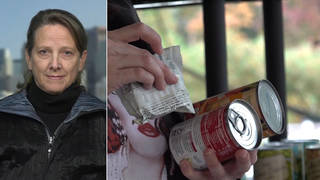
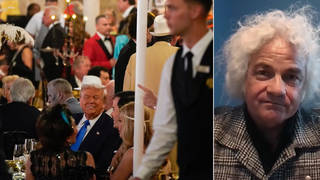
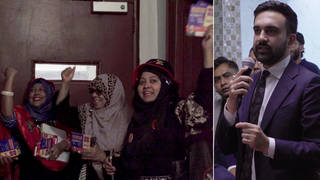
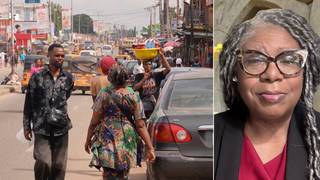






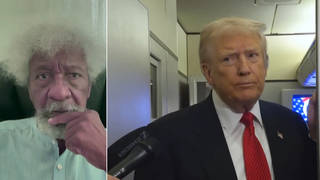
Media Options